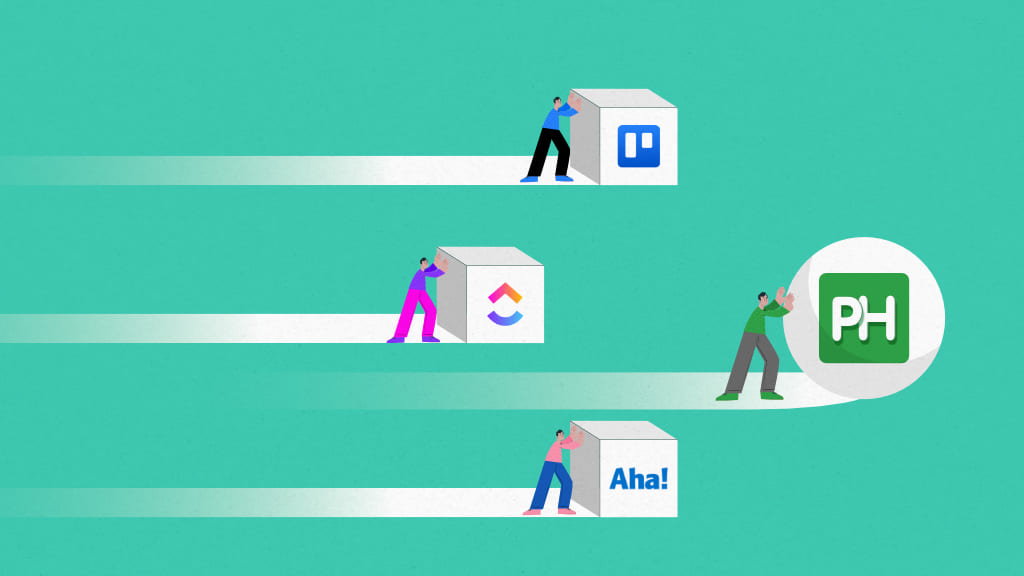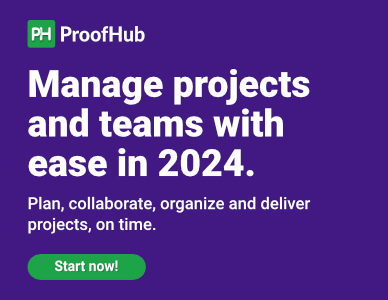“Lack of direction, not lack of time, is the problem. We all have twenty-four hour days.”– Zig Ziglar, motivational speaker, author, salesman
Do you feel like time getting short and slipping away from your hand like sand when executing a project?
Well, not investing the right efforts and energy at the right time in the right direction can plague the value of the project, but not to worry, work prioritization tools are there to help you never miss the beat.
Throughout my years of working as a manager, I can understand that being the decision-makers of our organization, even a single bad decision can raise a question about our decision-making capabilities.
Why am I saying this?
Because meeting deadlines while keeping track of other valuable resources like time, money, and team members, was once a nightmare for me too.
Prioritization has become an effective professional skill one can, or rather, should learn. But, believe me, no matter how simple it sounds, it is just easier said than done.
In this article, after months of time investment, I have compiled a list of the 10 best tools for prioritizing tasks to help you keep pace with the project deadline. Apart from this, I have also highlighted the key features and weighed their pros and cons to help you make an informed decision.
10 Best work prioritization tools in 2024
1. ProofHub
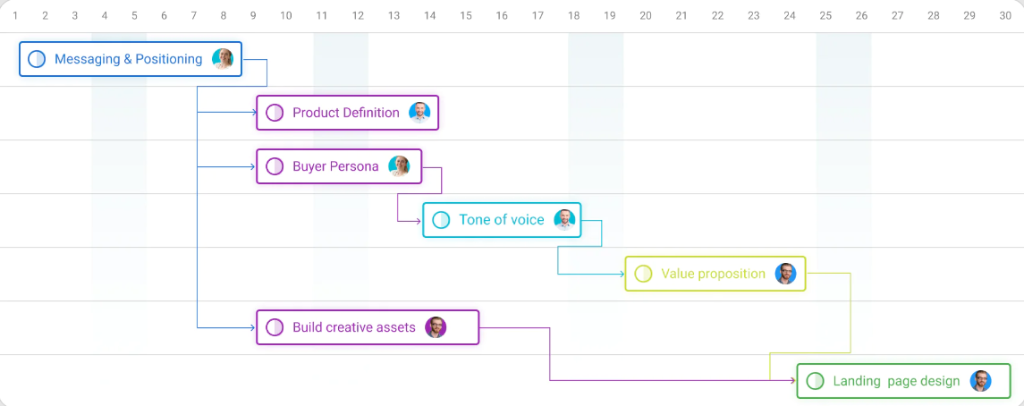
ProofHub is an intuitive all-in-one work prioritization tool to assist you in prioritizing projects that deserve your attention the most all under one virtual roof.
As a manager, I know how overwhelming the growing list of tasks may become. Let alone the urgent requests that keep on creeping through the daily task schedules, making reaching deadlines the easiest thing in the future. And, in the end, all you are left with is the time slipping down from your hand, and tasks keep on piling up.
Sounds familiar, right?
But not to worry!
Because ProofHub, the project management and team collaboration tool, is there for you to save the day. How?
Being the one who knows both inside and outside of ProofHub, mark my words that ProofHub is one of the best and most intuitive tools for prioritizing tasks to help you catch up with the task list growing at a huge pace. It lets you cut through the fog of multiple tasks to get things accomplished effortlessly and robustly.
Key features
1. Set deadlines (and filter as per the priority)
The major issue when prioritizing tasks is underestimating the load of work and the duration to get it completed. It not only derails the task progress but puts teams under unavoidable pressure and anxiety as the deadline gets closer. Also, assigning tasks to a team member already under load is another reason behind not being able to meet deadlines.
But, ProofHub comes to the rescue here with its advanced and thoughtful features.
It creates a visual platform for you to where you can track deadlines by setting start dates and due dates. It helps you manage the workflow as something urgent comes in between.
You can even add customized labels to communicate your task requirement without putting on any detailed description.
So, the rest of everything boils down to the availability of the individual which you can check by filtering out the tasks assigned to them.
2. Accurate time tracking (with custom time reports)
While getting prioritized tasks to the final stage is one thing, getting them executed on time is another. After setting a deadline, you can add estimated time to your task and compare it to the time actually spent by ProofHub’s time-tracking feature.
So, get a detailed idea of task completion rate by analyzing where things are getting stuck. After that get to solving and addressing the reason for the delay right away.
3. Delegate tasks (to multiple team members at once)
Every seasoned professional like you would agree with me that both assigning and prioritizing a task is a skill not everyone can nail.
“One of the true tests of leadership is the ability to recognize a problem before it becomes an emergency.”
An accomplished stage of a task can only be achieved if a leader is able to make a collective decision by taking into account every possible aspect. Effective planning can be obtained by keeping in mind the workload on team members which you can overview from the task filter section of ProofHub.
Assigning tasks to more than one team member by adding multiple assignees to a task and breaking tasks into subtasks leads to timely results with effective resource allocation.
4. Track progress (make changes on the go)
Staying up-to-date with the progress of prioritized tasks is crucial to move forward in the work stage in sync with the project deadline. And ProofHub solves your problem by providing its most appreciated task views to keep track of the work progress without taking much of your time.
The list of task views includes –
🪟 Board view – With every task categorized in a different column, you get a clear overview of the task workflow under different stages. It’s a truth shop to view and adjust the real-time task status with a drag-and-drop feature.
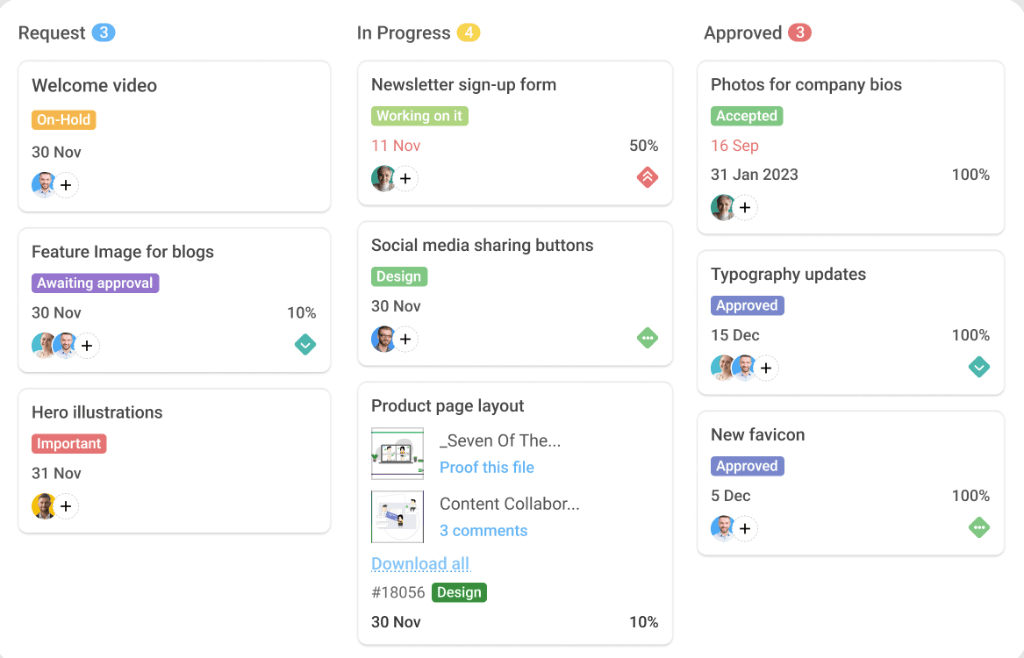
🪟 Gantt chart view – This view acts as a one-to-one visual chart to track the progress of a task in real time. It provides a clear understanding of how the tasks are related along with the dependencies to make a home run in the easiest way possible.
Let me make a confession here – It’s my personal favorite.
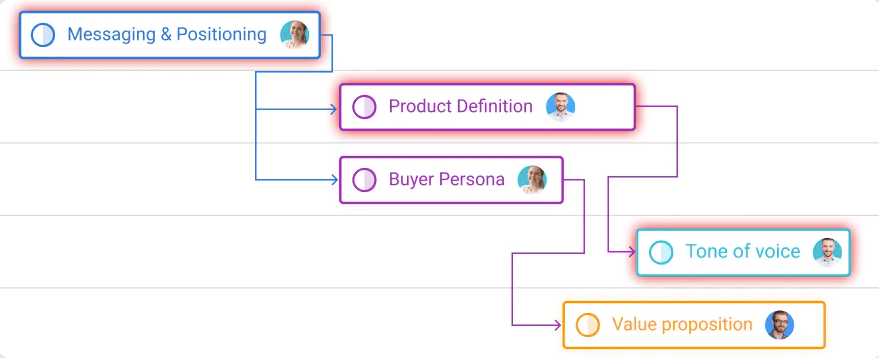
🪟 Calendar view – With the Calendar view you can visualize your tasks, events, milestones, and deadline all in one place. This task view gives a quick overview of your schedule on a daily, weekly, or monthly basis to make sure you are on the right track.
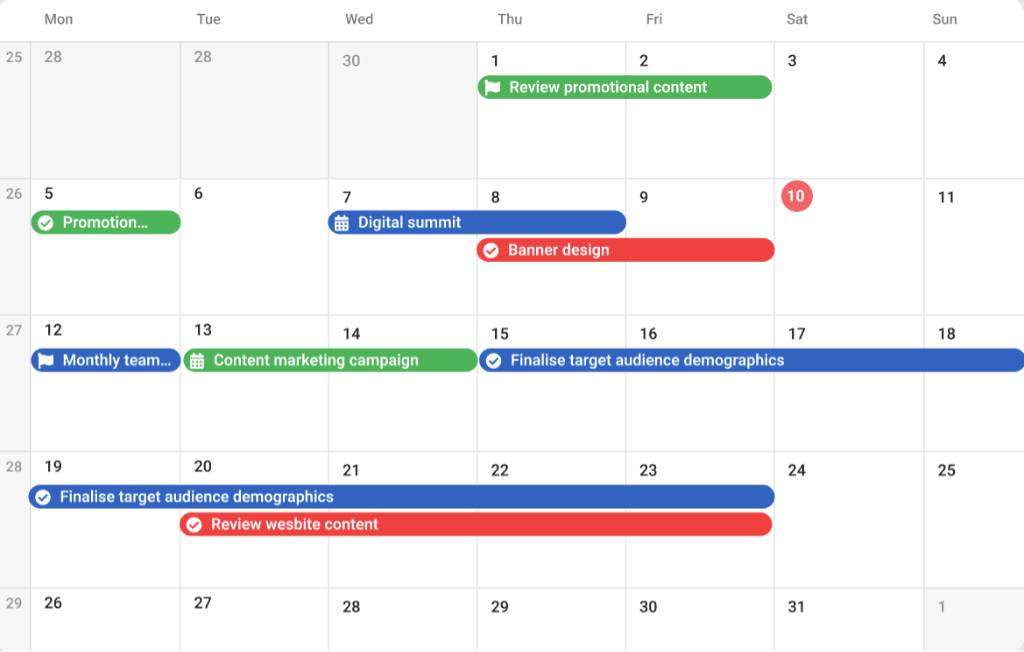
🪟 Table view – The most simplest and traditional (rows and columns) way detail of work progress you can obtain with the table view.
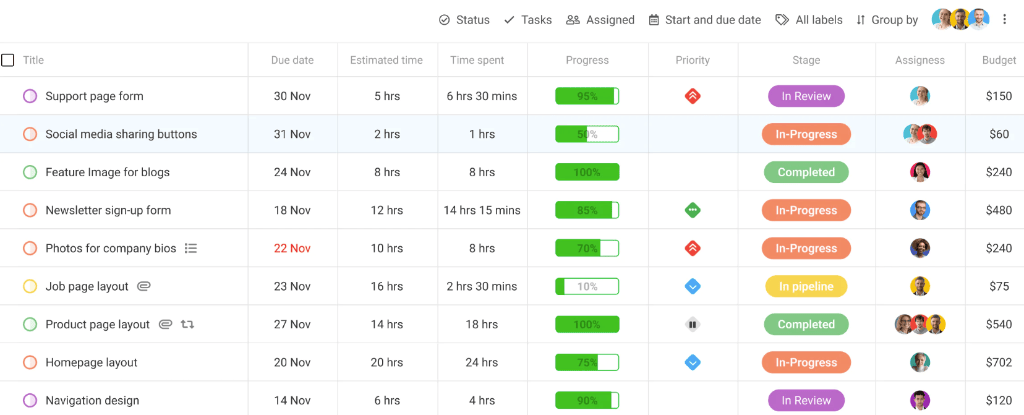
So, ProofHub allows you to stay on top of everything by helping you identify and eliminate the bottlenecks in real-time efficiently and easily with its multiple views.
5. Effective collaboration (with real-time communication)
Does collaboration seem a struggle between the team members, especially when dependencies are introduced? To leave no room for a blame game, ProofHub provides a single platform for your team to communicate and collaborate with each other.
I firmly believe that an organization is able to achieve its goals and get prioritized tasks done only when everyone is standing on the same page, not wasting any time, and working towards a common goal.
The built-in chat feature allows users to communicate in real-time with each other (both one-to-one or in a group). You can even get a specific team member’s attention by mentioning them in a particular task using @comments.
To keep everyone engaged and informed you can even use the discussion feature to bid farewell to having long, time-wasting meetings. Keep everyone in the loop, add privacy, ask questions, and organize conversations all-in-one place.
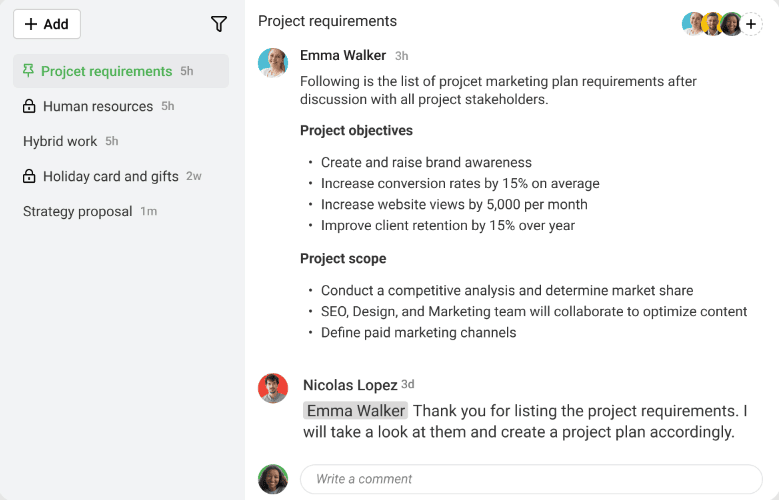
With ProofHub’s online proofing, getting feedback and review on documents, files, and designs is no longer an issue (not even by some margin) So, get real-time honest feedback and make revisions instantly.
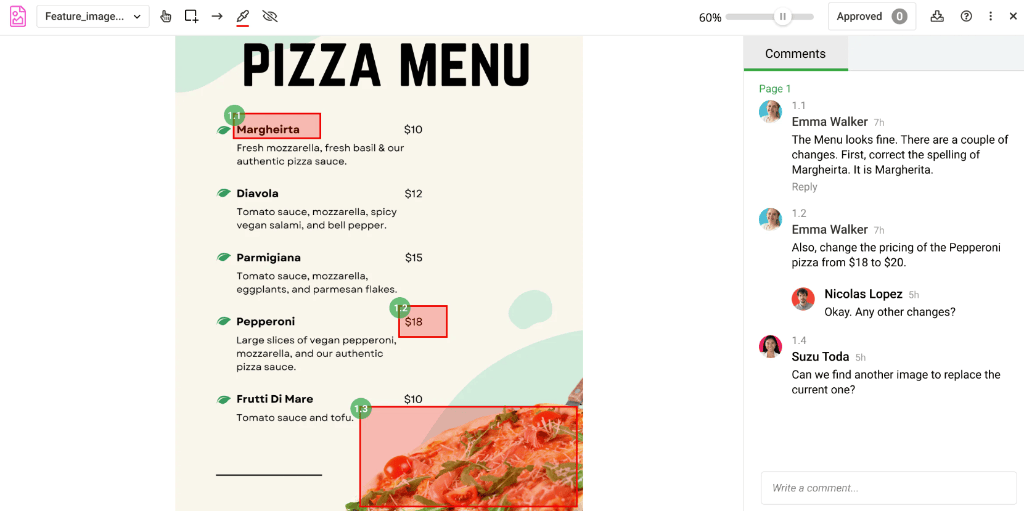
Pros
- Flat fee pricing. Add as many users as you want.
- An all-in-one platform to stop juggling multiple apps.
- A user-interface platform that is simple to navigate.
- Online proofing to get and give feedback on files, documents, and designs.
- Discussions to collaborate without wasting time on time-consuming meetings.
- Built-in chat allows you to stay connected with the team.
- Custom fields to add or remove dynamic requirements.
- Add multiple assignees to a task or subtask created.
- Customizable and intuitive reporting to stay on top.
- Centralized storage space and document sharing feature to effectively share files from one location.
ProofHub Verified Review on Capeterra
Cons
- Notifications can overwhelm you at times.
- Not recommended for individuals and freelancers.
- No built-in invoicing is available.
Pricing
If you are looking out for a robust task prioritization tool to keep your workload under control, then make sure to check out ProofHub.
With the flat fee pricing to offer – pay only for what you use, ProofHub offers a 14-day free trial before you make any long-term commitment with us.
Any great thing?
Yes, we won’t ask you to add any card details and there are no hidden fees associated so you can have full faith in us.
Our Essential plan includes features such as task management, online proofing, 15 GB storage, and more at $ 45/month (billed annually) for unlimited users. For additional advanced features, like priority support, custom roles and permissions, workflows, and more upgrade to the Ultimate Control plan starting at $89/month (billed annually) for unlimited users.
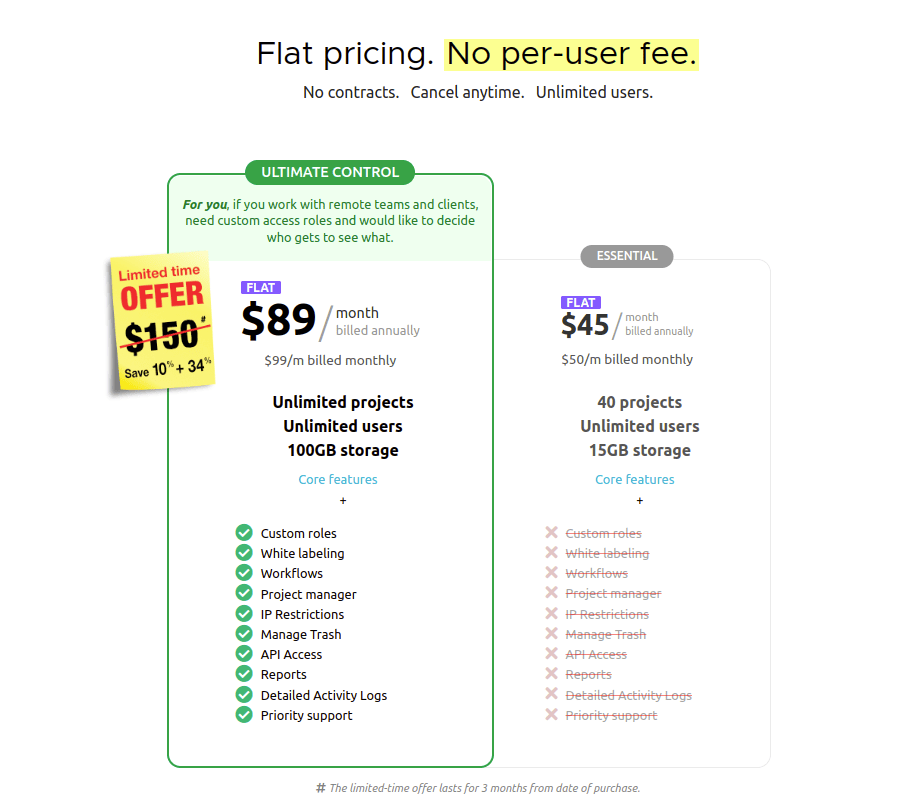
User Review
G2 – 4.5
Capterra – 4.6
2. ClickUp
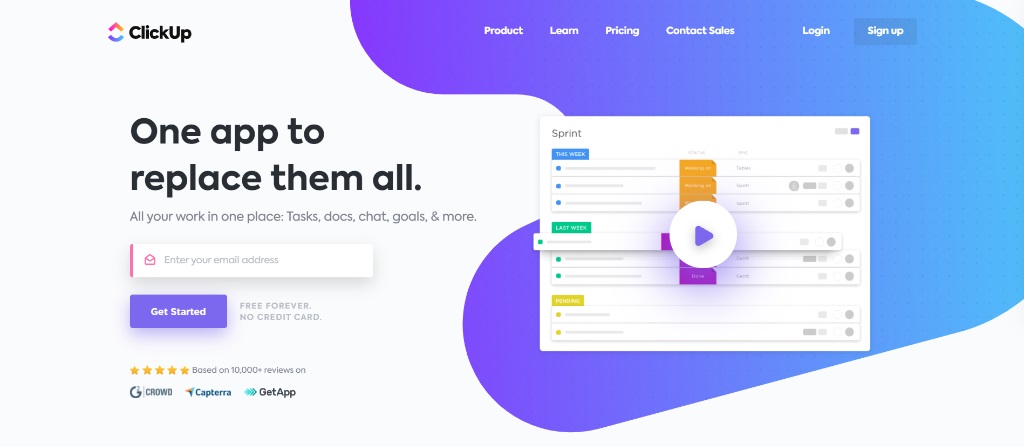
ClickUp makes its spot in the list of best tools for prioritizing tasks and projects for businesses. But is its functionality any worth prioritizing your tasks with its steep learning curve?
Well, this project management tool helps businesses, teams, and individuals, especially freelancers, to manage and assign tasks, track progress, and collaborate effectively from a single interface. However, not to forget, that many premium features are not included in the free forever plan.
So, would you seriously be able to bring productivity at the cost of manhours?
Key features
- Customized visual task views to track progress in multiple ways.
- Time tracking to get a glance at the team’s invested time.
- 100+ automation ways to take care of routine tasks.
- Multiple in-built templates to get started in no time.
- User-choice widgets to get customized dashboards
Pros
- With ClickUp you can customize workflow to manage the work your way.
- Creating subtasks between tasks is easy to keep the project moving forward.
- Task assignment is convenient and impressive. You can even hide it from anyone you want.
ClickUp Verified Review on G2
Cons
- The platform’s steep learning curve gets overwhelming and confusing for beginners.
- The Android mobile app is glitchy and doesn’t support multiple views.
- New users must contact unhelpful support for the free trial, as their live chat connects them to a chatbot that redirects to the help center.
Pricing
Apart from ClickUp’s Free Forever Plan, Four more plans are there to make a choice from – Unlimited, Business, and Business Plus at $5/month per user, $12/month per user, and $19/month per user respectively. Last but not least, Contact the sales team to know more about the Enterprise plan.
User Review
G2 – 4.7
Capterra – 4.7
3. Trello
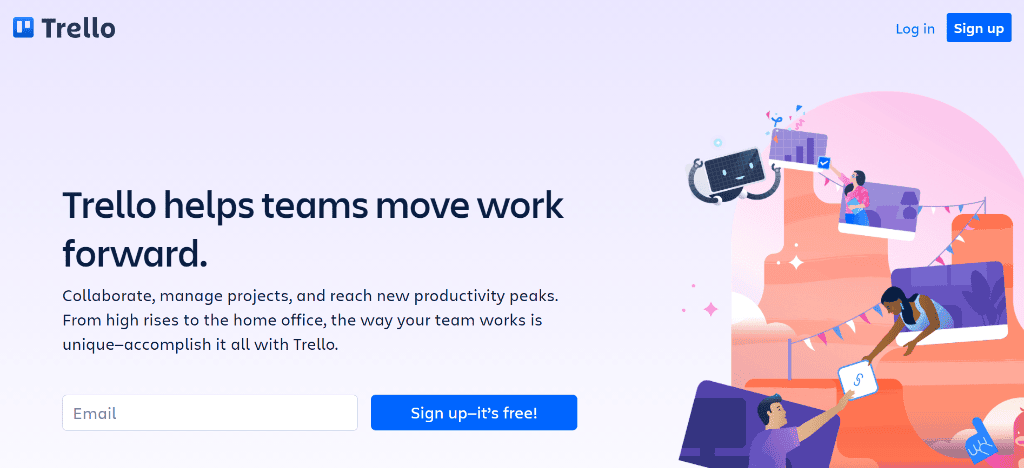
Trello with its commendable Kanban visual board and flexible user interface is a highly popular work and project prioritization tool among businesses. Despite the multiple customizable features to offer, Trello lacks certain functionalities.
The simple and easy-to-use interface of Trello revolves around the Kanban board with moving cars to visualize the task progress. However, if you are looking for a seamless workflow, dealing with a large number of cards or boards might weigh heavy on you.
Key Features
- Kanban board to visualize project progress from every angle.
- Add power-ups (plugins) to personalize the Trello experience.
- Extensive details and information are stored in a single card.
- Drag and drop feature to adjust start and due date on the fly.
- Dashboard to have a bird’s eye view of the project’s progress.
Pros
- An intuitive visually appealing kanban board view for better management of tasks.
- Accessible on multiple platforms like iOS, Windows, Mac, and Android.
- Easy-to-use interface to get head around.
Trello Verified Review on Capeterra
Cons
- High dependence on Kanban boards may not suit every individual’s needs.
- Multiple creations of cards build up confusion and cause inefficiency.
- Difficult to maintain and gets problematic with large projects.
Pricing
Trello’s pricing chart contains three paid plans and one free plan. If you are an individual or a team of few members, trying on the free plan of Tello is not at all a bad choice.
On the higher side, The Standard plan costs $5 per user per month (for small teams), and the Premium plan at $10 per user per month (for large teams).
For the Enterprise plan, contact the sale team for specific pricing.
User Review
G2 – 4.4
Capterra – 4.5
4. ProductPlan
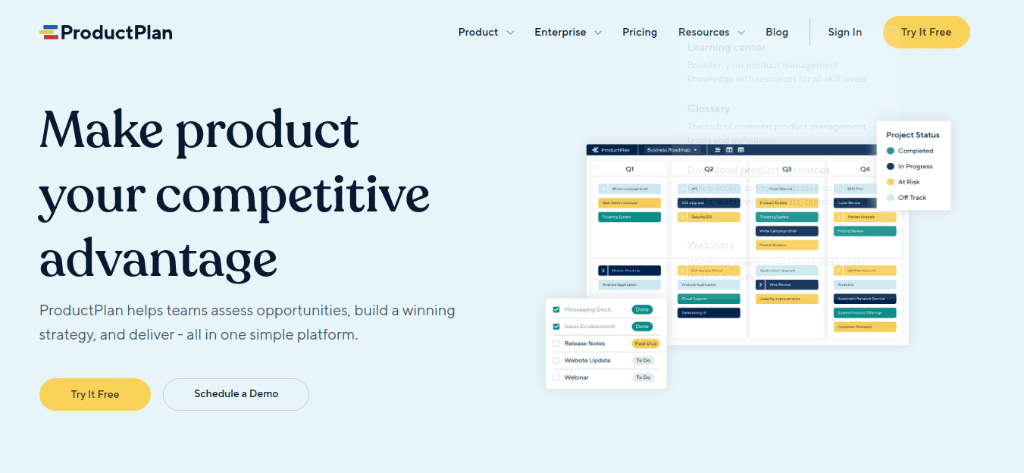
With the heavy reliance on roadmaps, ProductPlan assists you in creating a product strategy seamlessly and effortlessly. Its ability to create dependencies makes it a flexible workflow management software.
The roadmap is a plan of all the activities and tasks you intend to delegate to get to the end of the prioritization process. With multiple integrations to offer, including Azure DevOps, Trello, Jira, Microsoft Teams, Zapier, and more, you can share your roadmaps all across the organization without being concerned about its security.
Key Features
- Customized roadmaps to add priority work and share with others.
- Table layout to centralize product plan and prioritize work accordingly.
- SOC 2 certified advanced security features to keep data totally secured.
- Multiple integrations are available to keep on using the applications that you already love.
- Wide range of built-in roadmap templates to choose from.
Pros
- Simple and easy-to-use platform with fewer to no problematic functionalities.
- Advanced improvements with every coming update.
- Enhanced visibility through satisfactory resource management.
ProductPlan Verified Review on G2
Cons
- Gets heavy on the pocket for bigger teams or teams expanding.
- Sharing an overview or roadmap among teams is difficult.
- Restricted editing for everyone other than the sheet owner.
Pricing
ProductPlan breaks its pricing into three different plans – Basic, Professional, and Enterprise. The Basic plan starts at $39 per editor per month while the Professional plan costs $69 per editor per month. To get to know more about the Enterprise plan, you need to contact them and request a demo.
User Review
G2 – 4.4
Capterra – 4.4
5. Aha!
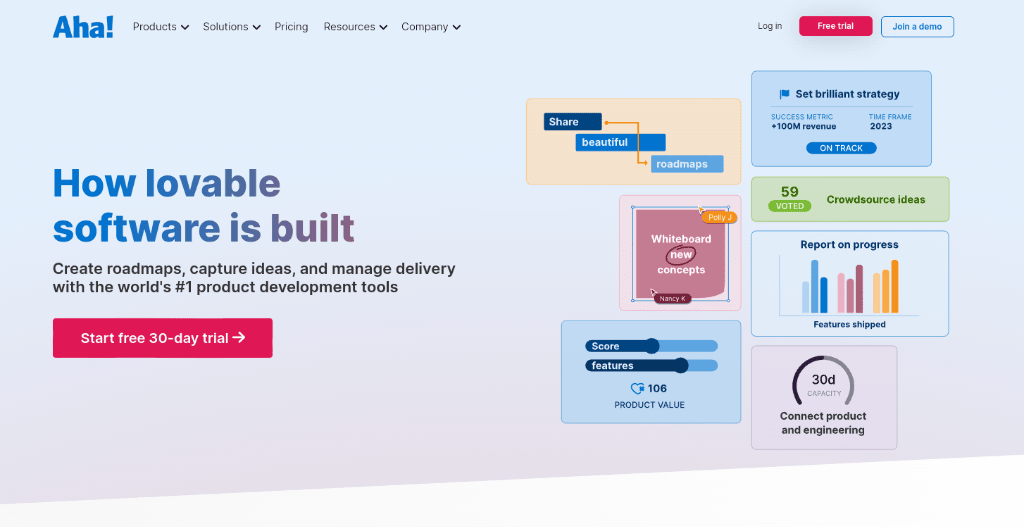
A great solution for product developers, Aha!, is a work prioritization software to build roadmaps by crowdsourcing feedback. It entails all the features to understand customers’ wants and needs.
Despite the multiple overwhelming features available, teh simple user interface allows your ideas and goals together on teh whiteboard. With Aha! you can understand user trends and make the most of that data to build an actionable strategy to optimize product delivery. You can even score your features on the basis of customer experience on teh scorecard.
Key Features
- Aha! Notebooks to craft some compelling documents, whiteboards, and personal to-dos to share and collaborate with a team.
- Over 40 templates to lay out a roadmap for a task.
- Live collaboration to get feedback out of your account.
- Customer-branded portal to capture and rank videos in one-centralized space.
- Inbuilt Aha! AI writing assistant to help you draft compelling content for writing meeting summaries, notes, and more.
Pros
- Create appealing diagrams or choose inbuilt templates to collaborate visually.
- Fully loaded with functional features to streamline business workflows.
- Tailored to fit specific business needs.
Aha! Verified Review on Capeterra
Cons
- Pervasive features can be startling for first-time users.
- Limited workflow automation capabilities.
- It gets expensive for growing businesses.
Pricing
With the 30-day free trial service, Aha! Pricing categorizes into 4 sections. First being the Aha! Develop starting at $9 per user per month and includes Aha! Notebooks essentials. Next, is the Aha! Notebooks at $9 per user per month. The other two, Aha! Ideas and Aha! Create, fall more on the expensive side at $39 and $59 per user per month respectively. The former includes the Aha! Notebook essentials while the latter includes both Aha! Ideas and Aha! Notebooks essentials.
User Review
G2 – 4.3
Capterra – 4.7
6. Google Keep
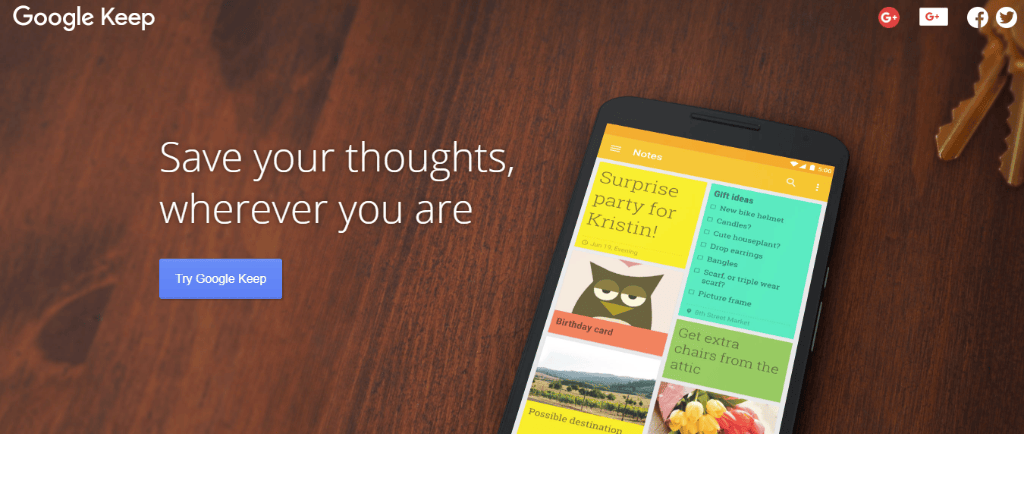
A software giant product, Google Keep is a note-taking app to collect your thoughts in the form of notes, audio, and more even when you are on the go.
Not fully regarded as a work prioritization software, Google Keep is a great option for teams with no hard and fast requirements for work prioritization stages. It doesn’t allow your train of thought to derail for up to 20000 character word limit and keeps them organized with labels, formatting, and colors. And when you are in no mood to write, just switch to the audio format and you are all ready.
Key Features
- Simple and visually attractive interface to keep photos and audio.
- Both location-based and time-based reminders are available.
- Notes pinning feature to keep whatever you want on the top.
- Coloring and other attributes for quick search.
- Centralized interface to write and share notes.
Pros
- Jot down every piece of information, detail, and even thoughts running through your mind. No restriction at all.
- Quick loading no matter the amount of content available.
- Categorization of notes using tags is easy.
Google Keep Verified Review on Capeterra
Cons
- Everything stored takes space up in the Google account quota which might soon reach its storage limit if stuffed in with large-size pictures.
- Formatting within the note is not possible.
- Character limit in a note is troublesome.
Pricing
Totally free to use.
User Review
Capterra – 4.7
7. Evernote
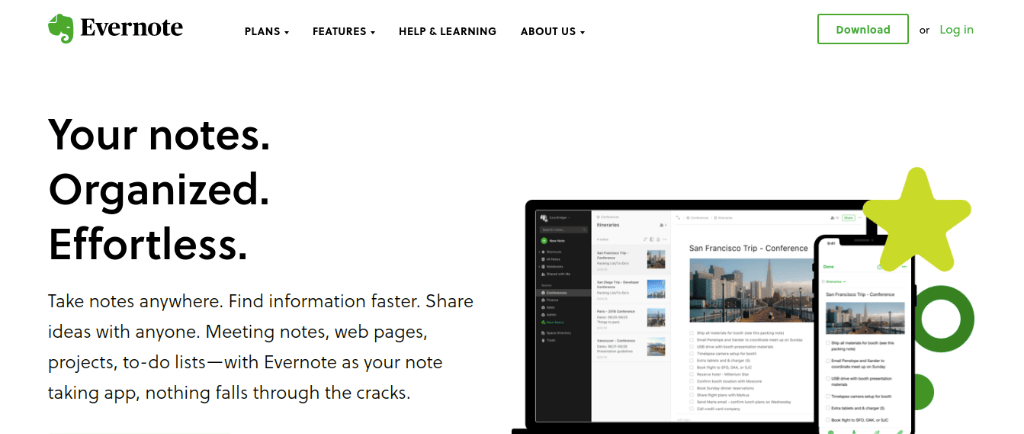
Evernote is the slightest modified version of Google Keep but with collaboration at focus. It is a note-taking app with a word detection feature to make the search game easy.
The platform allows teams to not only jot down their ideas and write notes, but save and organize them all in a single file. You can even use it as a lightweight tool for prioritizing tasks and scheduling a reminder for it to keep you updated.
Key Features
- Customizable and easy-to-install templates to make a prioritization checklist.
- User-friendly home surface for instant feature access.
- Offline access to notes.
- Connect Calendar and Evernote to stay informed.
- Easy accessibility from every device.
Pros
- Less dependency on hard documents to keep everything at a fingertip.
- Easy to create and access personal database.
- Enhanced workload efficiency due to powerful integrations.
Evernote Verified Review on G2
Cons
- Unreasonable pricing may become an issue for small business groups.
- Permission to share or edit the notes take forever to exert.
- Navigation of the platform is a bit steep due to overloaded features. becomes
Pricing
With 250 MB storage, Evernote Free lets you easily gather, organize, and locate everything you want while keeping them at your fingertips. The other two plans – Personal and Professional offer up to 10GB of storage at $14.99 and 20GB of storage at $17.99 respectively.
There is another plan for teams, known by the name, Evernote Teams includes additional features along with the features offered in the Professional plan. The billing here is done on a per-user basis.
User Review
G2 – 4.4
Capterra – 4.4
Read more: Evernote alternatives: 15 best note-taking apps for 2024
8. Airfocus
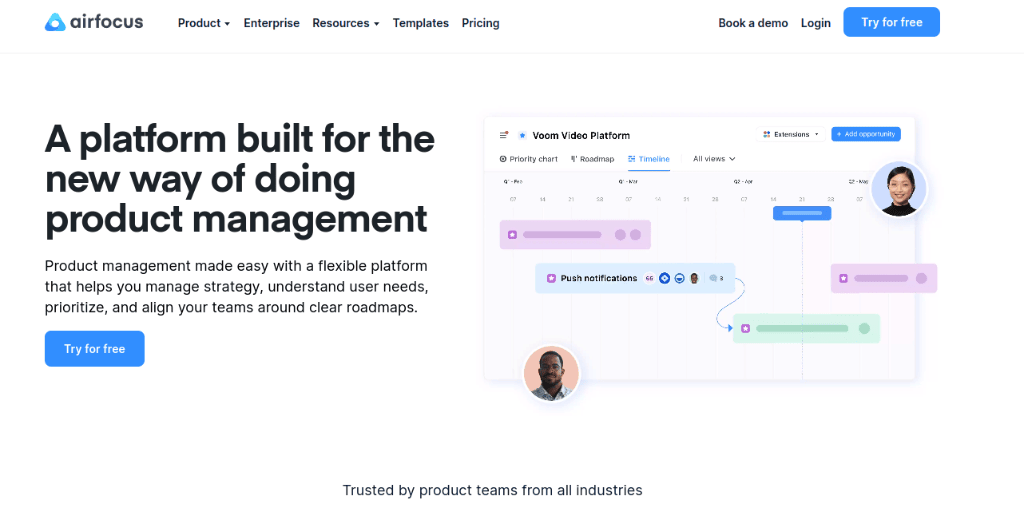
Airfocus is a modular product management tool to help teams make effective decisions on the prioritization of tasks. You can craft a customized workflow as per your preferences.
The tool with its algorithmic prioritization feature, automatically ranks tasks and provides a clear picture of task order to managers and decision-makers like you. The task order is decided on the base of customer feedback, strategy, and more. Also, you can personalize your services and pay only for the features you desire.
Key Features
- Customizable product management tool with in-built templates.
- Prioritize and organize your roadmap around a clear goal.
- Centralized valuable feedback from multiple sources.
- Built-in customized workflow for efficient work execution.
- Public portal to collect feedback and share the roadmap with the audience.
Pros
- Highly customized to work and set workflow as per your terms.
- Receptive to feedback and constantly improving.
- Easy sharing to bring everyone on the same page.
Airfocus Verified Review on Capeterra
Cons
- Does not provide good value for money.
- Overwhelming user interface with a difficult learning curve.
- No hierarchal prioritization design to define task structure.
Pricing
Apart from the 14-day free trial, the Essential and Advanced plans cost $19 per user per month and $69 per user per month respectively. However, to know more about teh Pro and Enterprise plans, you need to contact the salespeople. Also, Airfocus offers a great discount for budding startups on its Pro plan.
User Review
G2 – 4.4
Capterra – 4.5
9. Productboard
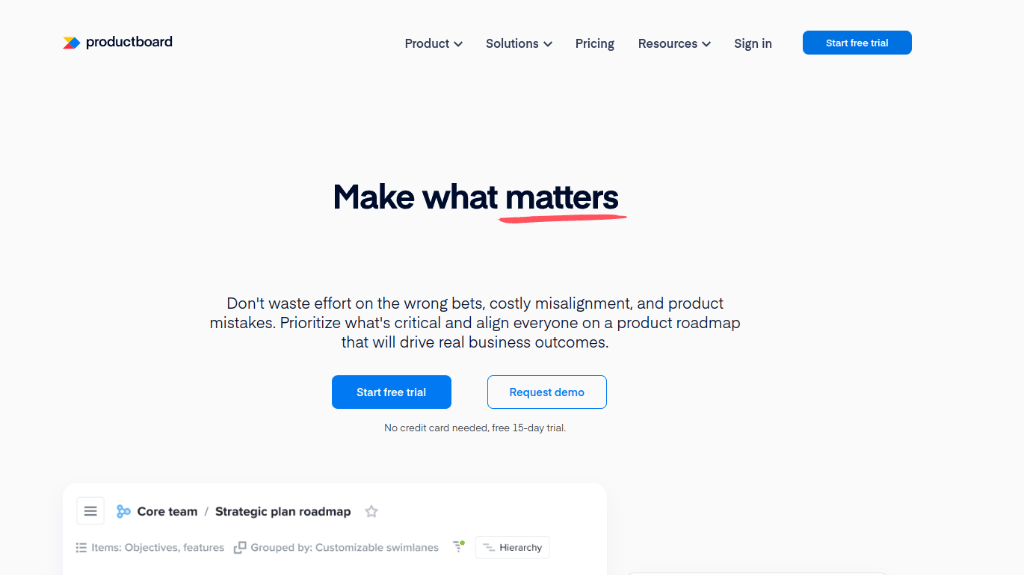
Prioritizing a task with Productboard is easy, as the platform with its prioritization system, allows teams to gather insights and take actions to prioritize work and projects accordingly.
From user insights to feature value, you can create a product roadmap and create a prioritization score for yourself out of 100 (customer scoring). It provides you with a clear vision of what customers want, and how you can effectively utilize your time and resources to meet their demands in no time along with a commendable user experience.
Key Features
- AI-generated summaries to come across trends.
- Customized prioritization roadmap of what matters the most.
- Customer segmentation to understand and prioritize customer needs better.
- Centralized platform to get customer insights.
- Decide the prioritization status based on customer scoring.
Pros
- Seamless collaboration with customers to get their responses on featured ideas.
- Getting feedback and taking actionable insights is easily possible in an all-in-one place.
- Easy creation and maintenance of roadmaps.
Productboard Verified Review on Capeterra
Cons
- Limited software development workflow integrations.
- Confusing pricing plans fall on a bit higher side.
- The distinction between internal insights and customer insights is difficult.
Pricing
You get a single roadmap to work on and that too free of cost. The Essentials plan costs $20 per maker per month. The Pro plan, on the other hand, includes all the features of the Essential plan apart from other robust features at $80 per maker per month. The Enterprise plan is wonderful for the bigger organizations, but to know the cost you need to contact their sales team.
User Review
G2 – 4.3
Capterra – 4.7
10. Todoist
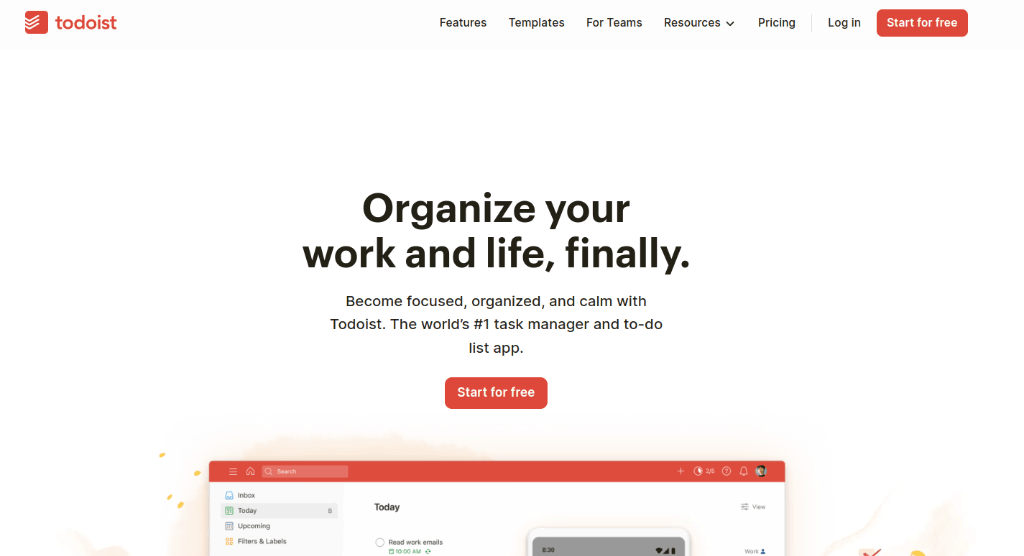
Last but not least, Todoist is a cloud-based work prioritization software to help your teams prioritize tasks by fragmenting them into subtasks for in-time accomplishments.
With a smooth learning curve, onboarding to the platform is not a big hassle. Having said that, introducing your team to this tool will not cause you much time. It will assist them in streamlining their day-to-day operations in a more structured way. The platform, although, apart from a to-do list and Kanban board doesn’t offer any other task view.
Key Features
- Timeline integration to stay aligned with the project deadline.
- Task labeling to sort and prioritize tasks accordingly.
- Automatic reminders to alert you about time-sensitive tasks.
- Todoist Karma points to reward your productivity through points.
- Notification to keep you updated when working.
Pros
- Seamless organization to keep everything on track and stay on top of it.
- Track the progress through customized task views.
- Easily accessible from both iOS and Android.
Todoist Verified Review on Capeterra
Cons
- Lacking a few important features in the free plan.
- Expensive paid version.
- Real-time communication is a problem when working on time-sensitive tasks.
Pricing
The freemium plan of Todist handles 500 tasks and 3 projects for 30 days. The Personal plan costs $3 per month and The Premium at $5 per month.
Apart from these, the other two plans – Business and Family serve unique needs.
The business plan starts at $12 per user per month and is great for teams and organizations. On the other hand, the Family plan is designed for families and groups (up to 5 members) at $10 per month.
User Review
G2 – 4.4
Capterra – 4.6
Why have I picked these task prioritization tools?
Making the selection of tools for work prioritization is like catching a specific fish out of all the fish in the vast sea. After all, what’s the catch worth if it doesn’t satisfy your specific needs?
While the hunt is a matter of promoting better work organization and doing effective planning for productivity enhancement, in my opinion, making sure that you don’t end up swirling in the array of software is crucial.
That is why, I am stating all the factors that I took into account to make the index of task prioritization tools so that you don’t need to make any extra effort. After that, all that you are left to do is evaluate if the features of the tools can get in sync with your company goals or not.
One major thing to never ignore is – Make sure to go for the tool that fits your budget.
Of course, you can thank me later. 😋
Just kidding.
Let’s take a look at the checklist of points.
- Reviews and recommendations – Gauging reviews and real testimonials are a must for me. And that was a part of my selection process. No one can give you deep insights better than the individuals who have firsthand experience with the product.
Real people, real experiences, real reviews.
- Functionality – Next step of my tool evaluation practice was to evaluate the feature and functionalities of the tool and compare it against the necessary specifications for project prioritization. After all, no features are worth any use if do not help you get things done faster.
- Accessibility – I checked whether the tool’s accessibility is wide or not and the need to commute, considering the hybrid and remote work culture prevalent these days. So, don’t worry. I took care of this aspect – a tool’s ability to operate from multiple platforms and devices, including mobile, desktop, tabs, and web browsers while on my hunt.
- Scalability – From the perspective of a decision-maker, I try to stay one step ahead and foresee the requirements of my growing team. So, my every tool recommendation throws light on the fact that it will be able to accommodate the increasing workload or not.
- Pricing – Well, although I compared the pricing of various tools on the basis of being too low in cost or high for teams and businesses of various sizes. My main goal was to evaluate if the tool returns value for money or not and fit the budget and team size.
- Ease of use – When getting things done is such a big task in organizations, I surely didn’t want to recommend a tool that could add an extra layer of load on teams. After all, no one has time to get their head around something complicated.
- Pain Points – While choosing a good task prioritization tool, I opted for the ones that hold the capacity to not only help in filtering, evaluating, and then prioritizing the task. But assist in task scheduling too while mitigating the potential setback in the face of dynamic challenges.
What is a work prioritization tool?
A tool for work prioritization is like a personal assistant to assist you in prioritizing tasks effectively by assisting you in task scheduling, workload distribution, resource allocation, task prioritization, time management, and tracking task progress to make smart decisions.
While not being able to communicate clear task goals is a potential pitfall one call fall into, clearly communicating the purpose and direction paints a clear picture for team members to make a huge impact.
Work prioritization tools can be used by businesses of all sizes, and teams, to stay focused and on the top of project lifecycle.
Features to look for in a work prioritization tool
When making a selection for a work prioritization tool for your business, I suggest you evaluate your choices on the factors mentioned below and get the best suit for you.
- Time Management – Ensure the task prioritization tool offers extensive time-managing capabilities, like setting deadlines, adding estimate times, time tracking, et.al, so that project execution doesn’t suffer. Giving reminders or notifications to users let them stay on track and aware of time-sensitive commitments.
- Task Management – While making your selection for a tool for work prioritization, choose the one that provides effective task management and workflow management capacity to stay ahead of the curve. A task prioritization tool should allow users to be accountable by creating and assigning tasks with intricate details like titles, descriptions, and assignees.
- Centralized Storage Space – By centralizing the scattered files, documents, and designs, a robust task prioritization tool eliminates the need of juggling multiple apps together and nips the time wastage in the bud. So, make sure to select the one that provides a centralized platform where your teams can work together in harmony under one roof. And, most importantly, are not wasting their time looking around.
- User-Friendly Interface – The product should have an intuitive user interface that is simple to use and won’t leave your team’s brains spinning. The tool should be loaded with extensive features to make it easier to interpret task status and progress at a glance while matching the business goals and the work style of your team.
- Slightest Learning Curve – When you are out to make a work prioritization software purchase, look for the one with a minimal learning curve. It should be user-friendly and make the user boarding feel like a breeze with minimal setup requirements. Your selection should be able to simplify the process of task prioritization than doing otherwise.
- Communication & Collaboration – In getting prioritized tasks to the final stage, communication and collaboration between team members are crucial. So, make sure the tool you choose should be able to facilitate the same by providing a single platform for your teams to discuss task-related matters, share files, add comments, engage in conversations (both individually and in the group), mention team members in comments, and more.
Why is it important to prioritize tasks at work?
Task completion is like running a show on the stage with the aim of entertaining the audience (satisfying customers with task completion). Where the execution of the show greatly depends on being able to prioritize important aspects, the efforts required in doing so are enormous.
But the bitter truth is that the audience doesn’t care what goes behind the curtain. All they want is a great show.
Task prioritization is more than just providing value to the task. It is more of evaluating the need of the hour considering crucial factors like budgetary constraints, scope creep, potential setbacks, resource allocation, and more while maintaining the work balance.
So, the question is what do you get from an effective project prioritization framework in place? Let’s explore.
- Deadlines met – When you learn the art of prioritization and time management, the first thing you get to master is the ability to meet project deadlines. By identifying tasks with urgent or time-sensitive requirements, setting priorities and deadlines straight, and communicating clear goals and objectives of the tasks, teams can work accordingly to complete the tasks on schedule.
- Enhanced productivity – By setting your priorities clear, you mitigate even the slightest chance of confusion and distractions among the team. The practice boosts productivity levels and overall performance, allowing individuals to yield significant outcomes in less time.
- Resource allocation – Workload management becomes a breeze when resources are allocated efficiently. And this can be obtained only when you have a clear insight into goals and manpower well-suited to the project needs. Finances and required equipment are other factors to achieve the desired result.
- Fosters collaboration – Team members coordinate their efforts in accordance by coordinating and communicating when several people work together to achieve a common goal. Effective collaboration arises from prioritizing tasks due to greater clarity and transparency among team members.
- Reduced stress – A seamless workflow occurs naturally when priorities are established explicitly and everyone is aware of their jobs and responsibilities. By segmenting tasks on the basis of importance, urgency, and workload, no one feels overwhelmed and stressed.
- Adaptability and agility – Prioritization promotes the mindset of being open to the dynamic environment’s needs and evolving priorities. With clear objectives, teams become adaptable to uncertainties and agile to satisfy and capitalize on emerging opportunities.
- Effective decision-making – Prioritizing facilitates better decision-making skills in individuals. You look at things from multiple perspectives and evaluate various parameters, such as urgency, time constraint, resource allocation, and more before setting the priority level.
Master the work prioritization with ProofHub
Struggle with prioritization is real and you will surely agree with me that prioritization is a skill set that nobody is born with. (I mean, if you were, you are surely god’s favorite child.😂)
Well, jokes apart, the skill of prioritization is something that we can learn over years of experience. After multiple falls and failings, we learn to hone this talent as we grow professionally.
To upskill your talent and make you a pro in prioritizing tasks, ProofHub is here to change the game. To make sure you invest the right efforts and time in the right project, ProofHub allows you to be transparent with your team members. So that they know exactly what they want to do and save themselves from overwhelming deadlines and unnecessary stress and anxiety.
And voila!
You get complete control over your task progress and get the project delivered within the specific time frame.
Work prioritization tools FAQs
What is a prioritization tool?
A prioritization tool is a robust software to help you delegate, organize, and rank tasks based on the user’s demand, importance, urgency, or any other criteria. It allows the team to identify which task deserves their attention the most.
What are the three prioritization methods?
The three methods to prioritize work are the MoSCoW (Must have, Should have, Could have, Won’t have), the RICE (Reach, Impact, Confidence, Effort) Scoring, and the Kano model.
What are the 4 levels of prioritizing tasks?
The four levels of prioritizing tasks as per the ABCD method are Must Do, Should Do, Can’t Do, and Don’t Do. It depends on the urgency, importance, and impact.
What is the prioritization methodology?
It is a structured approach to identifying the importance of a task by evaluating it on certain parameters, such as importance, urgency, value, and consequence of delay.
What is the MoSCoW method of prioritization?
An abbreviation of Must have, Should have, Could have, and Won’t have, the MoSCoW method assesses tasks on the basis of importance and priority.
How do work prioritization tools help in managing tasks and projects?
Work prioritization tools build a single interface to manage, organize, track, and prioritize tasks effectively to meet deadlines, streamline communication, monitor progress, and make the team accountable.
Can work prioritization tools integrate with other productivity tools or platforms?
Yes, many work prioritization tools offer a plethora of integrations with other productivity tools to enhance their functionality and improve workflow efficiency.
What tools or methods do you use for prioritizing?
When it comes to prioritizing tasks at our organization, ProofHub has got all our trust. The platform allows team members to stay clearly informed and accountable for their tasks, making actionable efforts to be in sync with the project deadline.
